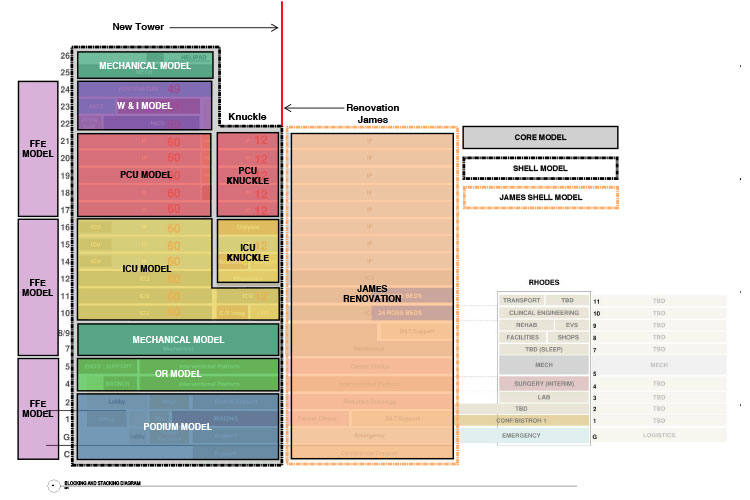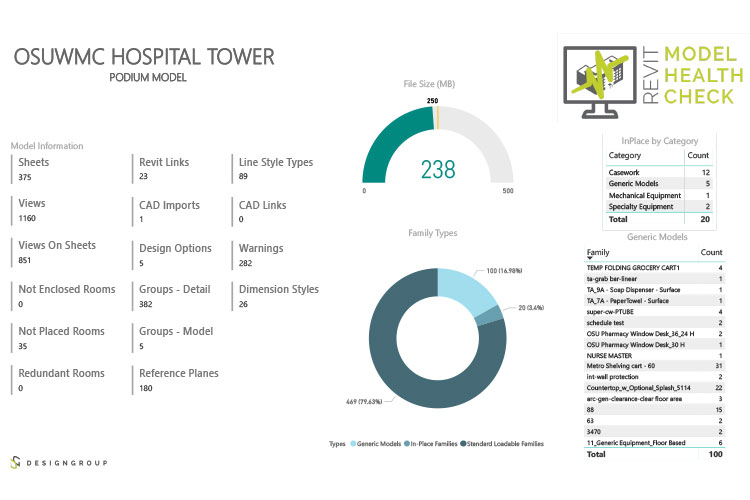Building information modeling, or BIM, provides powerful 3D design and review capabilities to any project. When the project is this big, though, it needs to be managed with extra care. In this Q-and-A, BIM managers from DesignGroup and HDR describe their successful collaboration on a massive new OSU Wexner Medical Center project.
By: Joshua Hostetler // DesignGroup BIM Manager + David Moore // HDR BIM Manager
The Ohio State University Wexner Medical Center (OSU WMC) is one of the largest university health systems in the world. It comprises multiple specialty hospitals on its main campus in Columbus, Ohio, including the University Hospital, the Brain and Spine Hospital, the Richard M. Ross Heart Hospital, and, most recently, the James Cancer Hospital and Solove Research Institute.
In 2017, the Medical Center’s executive leadership turned to a partnership between HDR and DesignGroup to help determine how to add a substantial new University Hospital inpatient and surgical tower into its existing dense campus.
The two firms relied on advanced, and in some cases original, BIM methodologies and collaboration to manage it all. In all, 230 team members and 15 multi-disciplinary firms created 40 Revit models representing 1.5 million square feet of facility design.
In this interview, DesignGroup’s Joshua Hostetler and David Moore of HDR describe how the project came together and what it took to create such an ambitious and complex BIM implementation.
How did the HDR/DesignGroup partnership begin? When were you brought into the project?
Joshua (JH): I was brought on early, based on my experience with Ohio State projects and the advanced BIM standards they have. From the beginning, I understood the importance of heavy BIM oversight on a project of this size. My role as overall BIM Manager was to help guide the Architectural team as well as all consultants in a successful and collaborative effort.
When Dave joined the team we expanded our BIM efforts — coordinating daily and working to provide the best processes and workflows. As time went on, my role shifted to support Dave in the daily efforts to resolve issues quickly.
David (DM): I joined the OSU project during the Design Development phase. My role as Architectural BIM manager included supporting the team’s daily modeling questions and issues, building super families, mentoring users on proper documentation processes, and other roles. Joshua and I divided up the BIM Management tasks to cover all aspects, from MEP to architectural, to verify all modeling efforts were coordinated. With HDR as the design lead, it was our job to set the standards in terms of workflow, content, and clarity.
On a project of this size and scale, how did you help it all come together?
JH: There were a lot of complexities: breaking out and managing models, sharing content across so many teams, streamlining communication between all team members, and more. We knew from the start that communication and organization were an absolute must. Ohio State’s required BIM standards helped us easily define our deliverables and set a clear understanding of how we would use BIM throughout the project.
We knew the team was going to be large, involving many firms. To streamline collaboration, we did the entire project on BIM 360, an Autodesk cloud-based platform for organizing, distributing, and sharing files all on a single system. This workflow allowed for real-time collaboration between all the firms, which streamlined our ability to coordinate, communicate more effectively, and make informed decisions.
We also assigned a designated Model Coordinator to each model, both Architecturally as well as in each consultant model . This provided a point person to help maintain the integrity of their model and assure standards were being followed. This also allowed for all questions and other needs for that specific model to be filtered through one person. Dave and I met with the Architectural Model Coordinators weekly and the consultant Model Coordinators bi-weekly. These meetings allowed for regular communication on design changes, BIM needs, model issues, and more.
DM: Larger-scale projects like this one, 500,000 square feet or more, present unique challenges for the Project BIM Manager and Project Model Coordinators. Preparing a strategy for model break-up is vitally important — your models need to be set up in the most efficient way possible.
We break up models so that opening, closing, and saving times can be as fast as possible. We also do this so that each model is more manageable for the team members to work with. The more efficient the team can work results in less down time. Those time savings directly equate to budget savings.
We implemented a central location for all correspondence relating to graphic standards, approved content, and proper workflows. This was a way for us to have documented standards that each team member could refer to. We used the General Administration (GENAD) Model as a container file for standard walls, doors, view templates, and more. This allowed for easy distribution of project standards to all models and teams. And we also created a modeling process through Worksets within Revit that allowed for more control over all model elements. This allowed users to only work with what they needed leading to faster models, opening and saving times, and increased productivity.

What are some issues you experienced that good BIM oversight helped resolve?
JH: Working with 18 Architectural models on a project of this size, we knew early on an issue would be keeping these models light, efficient, and problem free. Slow, inefficient models can quickly lead to massive time loss as well as major rework if proper modeling practices are not followed. From the start, we implemented a tool I created called the Model Health Check, which helped improve the performance of our Revit models and processes. This tool made us aware of our major problem areas as well as helped assist our teams in identifying and correcting inefficient modeling habits. The weekly Model Health Check reports we ran helped us optimize model performance, increase productivity, and reduce team frustration.
After a few months of using this tool, we worked with HDR’s digital team to implement a live report embedded directly into the Revit models. This allowed our teams to view a Health Report for their model in real time, updated every four hours. We used it to stay on top of most issues and help keep every model manageable for the team.
DM: One of toughest jobs as a BIM Manager is producing the most coordinated and efficient models for both team use and eventual model hand off to the owners. As team members enter the modeling environment, each individual brings their own strengths, weaknesses, and ingrained bad habits. Bad modeling habits present a unique challenge as there are a few key workflows that are frowned upon and can significantly impact the efficiency and health of the project. To alleviate modeling issues, and to keep the entire team productive, we employed an automated monitoring program that prevented bad Revit practices by tracking when certain tools and workflows were used. This tool also made it possible for us to make just-in-time suggestions to the team so they were aware of alternative solutions.
On a project this size, spaces or layouts can be highly repetitive. It is not uncommon in these situations to model that area once, group everything together, and copy that layout around. We went a different route and implemented the concept of super families (combining multiple families in a nested environment to create a full layout). This was done for several reasons: Groups are inefficient, add additional weight, and are often unstable. Taking this approach was the best solution for revising multiple spaces quickly.

How did the partnership between DesignGroup and HDR improve the BIM process?
JH: Having the two of us together allowed us to explore all options or potential solutions to issues in a very powerful way. Dave and I pulled from our experiences and looked for better ways to do things. We combined resources and implemented newly created tools to push the boundaries.
One example was a unique workflow solution called Sandbox Models. This process let designers work in detached models for design studies and client requests without having to constantly make changes in the live model. Once the studies were finalized, we could then swap the geometry in the live model with relative ease. This also made the live models more efficient.
DM: Through our combined efforts, our partnership often improved workflows and processes resulting in time savings and reduced rework. One example I enjoyed was how we shared and distributed our model content. We used BIM 360 and its central location to make all standard families easily accessible and consistent across all models and drawings. Storing this information in BIM 360 also allowed us to consolidate our Project Library making it clear to all users how to best access the correct content.
What lessons did you learn? How can you further improve BIM in the future?
DM: To be successful on large scale projects like OSU, you need to get out in front of potential pitfalls. This includes having a clear and concise understanding of owner’s expectations. It’s the best way to avoid tons of rework later in the documentation process.
JH: One area I feel we did better on in this project, but can always improve upon, is the amount of BIM oversight and when that oversight is brought in. BIM Managers or Project BIM leads need to be brought on board early to help plan, strategize, and set up efficient workflows that can be used throughout the rest of the project. The better your BIM plan, the more successful the project team will be.
With today’s aggressive project schedules, it is vitally important to use our tools in the most effective manner possible. BIM allows us to streamline this process and maximize our use of 3D models. We’ve found that there are significantly fewer RFIs when BIM is used correctly in all phases of a project. In addition, it allows the owner to see what he/she is getting with the aid of walkthroughs and accurate renderings. BIM has created a solid connection between design and construction that has never been felt before. Instead of asking how we can get architects, engineers, and construction managers to collaborate efficiently, we are now asking how we can use BIM to make the process even faster and more efficient.
This project plans to start construction Q1 of 2021 and open in Q4 of 2025.

Joshua Hostetler // DesignGroup BIM Manager
Joshua is passionate about Building Information Modeling (BIM) and how, when used effectively, it can enhance communication and collaboration between all team members. He believes that when using innovative technology, it allows the team to find new and creative ways to design buildings that lead to better outcomes. He combines his seven years of BIM expertise with five years of design experience in all phases of projects from planning to construction. This allows him to be a valuable resource and work seamlessly with the design team from initial studies through final design and construction.

David Moore // HDR BIM Manager
David brings more than 34 years of architectural experience in a wide variety of building typologies including academic, science + technology, commercial, and healthcare. He brings his vast knowledge of building structures, systems and materials along with his early adoption philosophy to leverage the power of Revit & other BIM related processes. Through working with project leadership, clients, and consultants he has coordinated BIM efforts across multiple disciplines, models, and software platforms to ensure the team is synchronized in following both internal and client defined standards.
